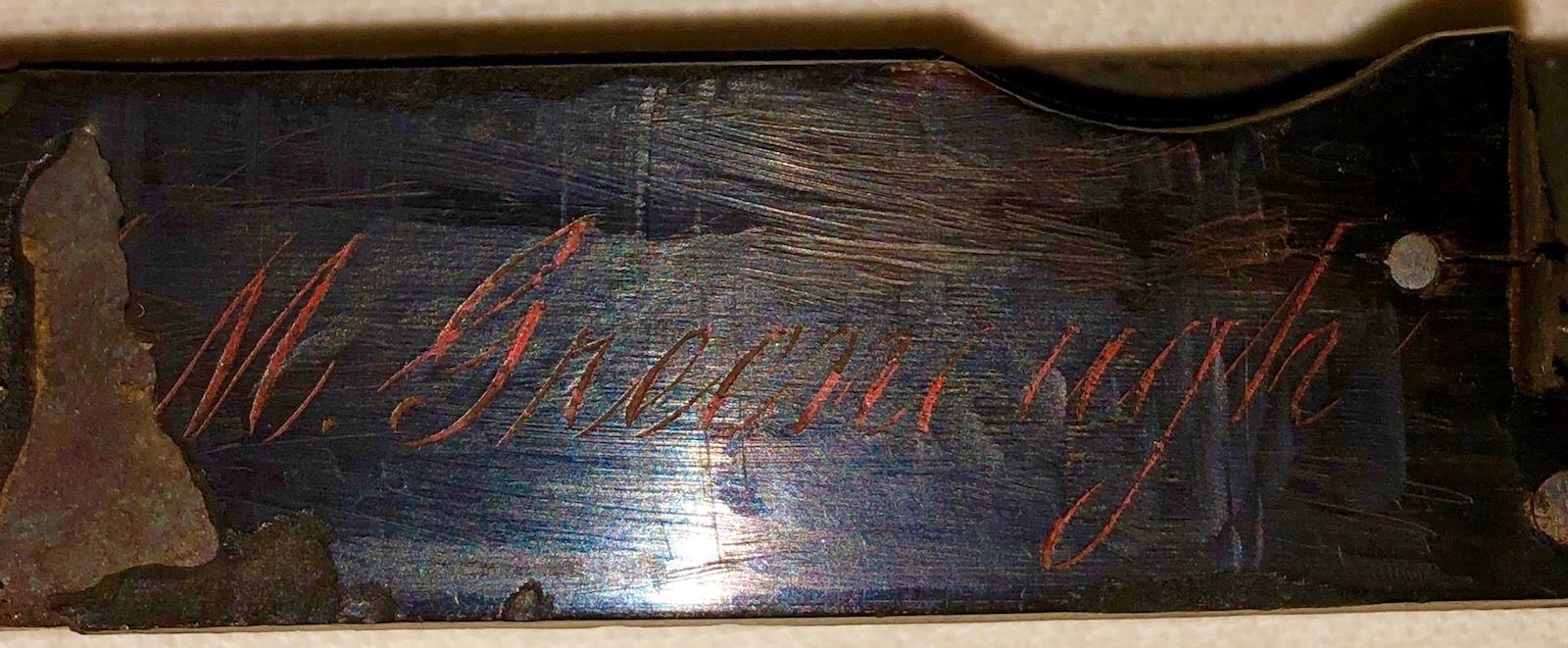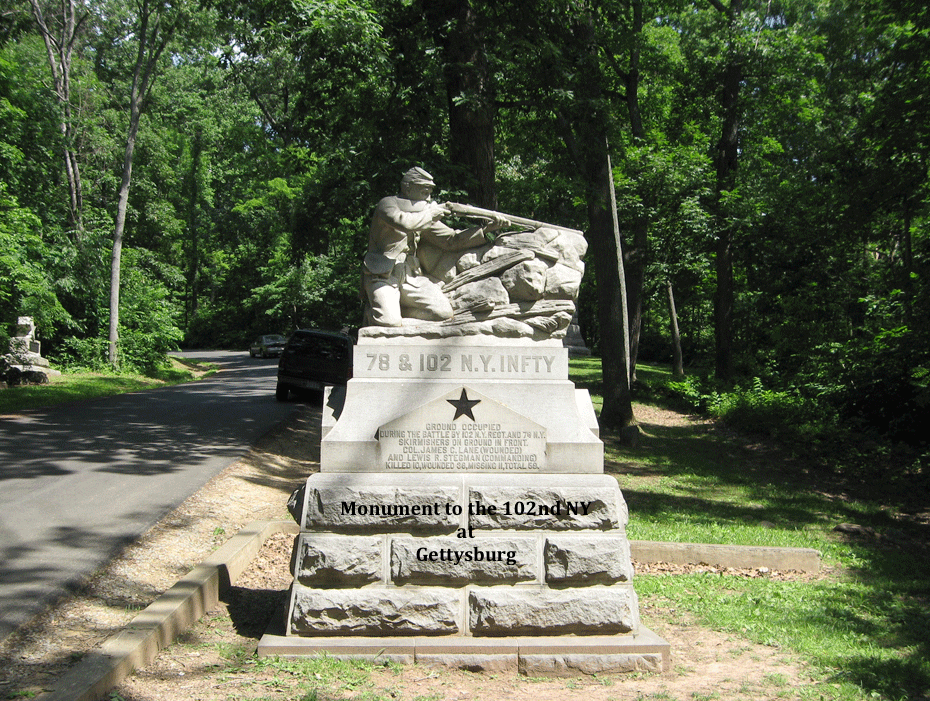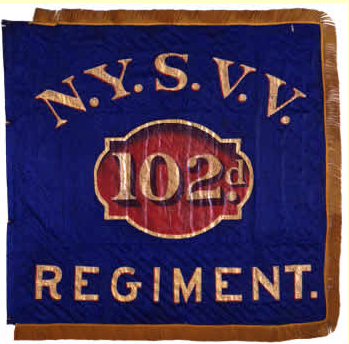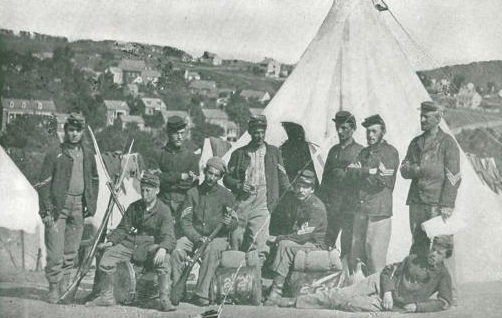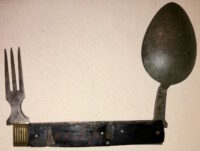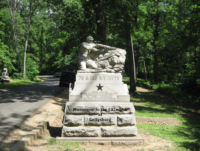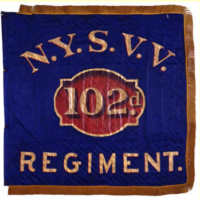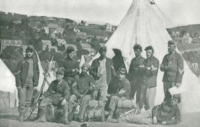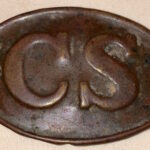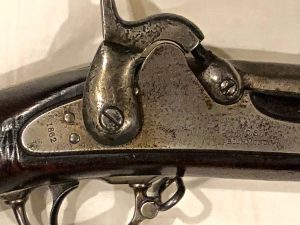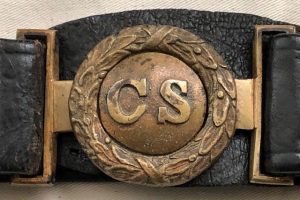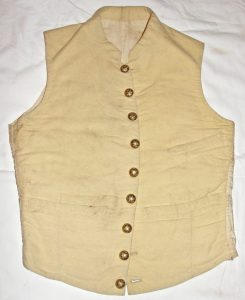Civil War Id’d Combination Fork and Spoon – POW 102nd NY Infantry
Civil War Id’d Combination Fork and Spoon – POW 102nd NY Infantry – This combination fork and spoon are the half aspect of a knife, fork and spoon combination that many Civil War soldiers purchased commercially to take into service when they embarked with their regiments. This example is a higher grade type, with one end, capped in brass and the exterior sheathed in horn. Both the spoon and fork are in good condition and readily snap in and out of the body of the utensil. The knife half of the combination is no longer present. Decoratively impressed in the horn of the utensil and filled with hardened, red paraffin wax, is the name of the war time owner – Milton Greenough. Greenough enlisted in the 102nd NY Infantry in late 1861, then re-enlisted in 1863; he would serve with the 102nd until nearly the end of the war, when he was captured near Wadesboro, North Carolina; he was released about one month later at Aiken’s Landing, Virginia. Closed, this utensil measures approximately 4” in length.
Milton E. Greenough – Residence was not listed; 20 years old. Enlisted on 11/10/1861 at Colchestr, VT as a Private. On 12/1/1861 he mustered into “E” Co. NY 102nd Infantry He Re-enlisted on 12/30/1863 He was Mustered Out on 6/20/1865 at Annapolis, MD He was listed as: * POW 3/6/1865 Wadesboro, NC * Released 4/2/1865 Aiken’s Landing, VA Promotions: * Corpl Other Information: born in Vermont Member of GAR Post # 18 (McPherson) in Traverse City, MI After the War he lived in Traverse City, MI
102nd NY Infantry
( 3-years )
| Organized: on 3/1/62 Mustered Out: 7/21/65 at Alexandria, VAOfficers Killed or Mortally Wounded: 7 Officers Died of Disease, Accidents, etc.: 0 Enlisted Men Killed or Mortally Wounded: 66 Enlisted Men Died of Disease, Accidents, etc.: 82 (Source: Fox, Regimental Losses) |
| From | To | Brigade | Division | Corps | Army | Comment |
| Jun ’62 | Jun ’62 | 1 | Sigel’s | Department of the Shenandoah | ||
| Jun ’62 | Aug ’62 | 1 | 2 | 2 | Army of Virginia | |
| Aug ’62 | Sep ’62 | 2 | 2 | 2 | Army of Virginia | |
| Sep ’62 | Oct ’62 | 2 | 2 | 12 | Army of Potomac | |
| Oct ’62 | Sep ’63 | 3 | 2 | 12 | Army of Potomac | |
| Sep ’63 | Apr ’64 | 3 | 2 | 12 | Dept and Army of Ohio and Cumberland | |
| Apr ’64 | Jul ’65 | 3 | 2 | 20 | Dept and Army of Ohio and Cumberland | Mustered Out |
102nd NY Infantry – ( 3-years ) Organized: on 3/1/62 Mustered Out: 7/21/65 at Alexandria, VA Officers Killed or Mortally Wounded: 7 Officers Died of Disease, Accidents, etc.: 0 Enlisted Men Killed or Mortally Wounded: 66 Enlisted Men Died of Disease, Accidents, etc.: 82 (Source: Fox, Regimental Losses) From To Brigade Division Corps Army Comment Jun ’62 Jun ’62 1 Sigel’s Department of the Shenandoah Jun ’62 Aug ’62 1 2 2 Army of Virginia Aug ’62 Sep ’62 2 2 2 Army of Virginia Sep ’62 Oct ’62 2 2 12 Army of Potomac Oct ’62 Sep ’63 3 2 12 Army of Potomac Sep ’63 Apr ’64 3 2 12 Dept and Army of Ohio and Cumberland Apr ’64 Jul ’65 3 2 20 Dept and Army of Ohio and Cumberland Mustered Out
NEW YORK ONE HUNDRED AND SECOND INFANTRY (Three Years) One Hundred and Second Infantry.-Cols. Thomas B. Van Buren, James C. Lane, Herbert Hammerstien, Harvey S. Chatfield; Lieut.-Cols., William B. Hayward, James C. Lane, Harvey S. Chatfield, Oscar J. Spaulding; Majs., James C. Lane, F. Eugene Trotter, Gilbert M. Elliott, Lewis R. Stegman, Oscar J. Spaulding, Reuben H. Wilber. This regiment, known as the Van Buren light infantry, was principally recruited at New York city, and was formed by the consolidation of the Von Beck rifles under Col. R. H. Shannon, and part of the McClellan infantry under Col. S. Levy, with Col. Van Buren’s command. The organization was completed later by the addition of two companies from the 78th Cameron Highlanders and Co. A, 12th militia, and was mustered into the U. S. service from Nov., 1861, to April, 1862. In July, 1864, its ranks were filled by the transfer of the officers and men of the 78th N. Y. infantry. On the expiration of its term of service the original members (except veterans) were mustered out, and the regiment, composed of veterans and recruits continued in service. Early in June, 1865, it received by transfer the remaining men of the 119th, 154th, 137th, 149th, 134th, and 184th N. Y. Vols. The regiment, eight companies, left the state on March 10, 1862, followed by Cos. I and K on April 7. Assigned to the 2nd brigade, 2nd division, 2nd corps, Army of Virginia, it fought its first severe engagement at Cedar mountain, where its loss was 115 killed, wounded and missing. The regiment then moved with its corps to the support of Pope, fought at the second battle of Bull Run, and went into position at Chantilly, but was not engaged. In the same brigade and division, 12th corps, it was actively engaged at Antietam, losing 37 killed, wounded and missing, and was then successively engaged in the minor actions at Lovettsville, Ripon, Hillsboro, Winchester, Wolf Run shoal, and Fairfax Station, going into winter quarters at Stafford Court House. At the battle of Chancellorsville the 102nd, which fought in Geary’s division of the 12th corps lost 90 killed, wounded and missing. It was heavily engaged with the “White Star” division at Gettysburg, where its total loss was 29. It followed with its corps in pursuit of Lee’s fleeing army, being engaged at Ellis’ ford and Stevensburg, and in the latter part of September moved with the corps to Tennessee to reinforce Gen. Rosecrans. It engaged in the midnight battle of Wauhatchie; then started on the Chattanooga and Rossville campaign, fighting the famous “Battle above the clouds” on Lookout mountain, where the division led the advance; then fought at Missionary ridge and Ringgold gap, its loss in the campaign being 14 killed, wounded and missing. In the same brigade and division, 20th corps, the 102nd was with Gen. Sherman all through his Atlanta campaign, fighting at Villanow, Mill Creek gap, Resaca, Calhoun, Cassville, Dallas, Acworth Kennesaw mountain, Chattahoochee river, Peachtree creek, where its losses amounted to 53 in killed, wounded and missing, and at Bald hill. It moved in November with Sherman’s army on the march to the sea, shared in the siege of Savannah, its active service closing with the campaign in the Carolinas, during which it was engaged at Wadesboro, Averasboro, Bentionville, Goldsboro, Raleigh, and Bennett’s house, losing 18 killed, wounded and missing during this final campaign. It was mustered out under Col. Chatfield, July 21, 1865, at Alexandria, Va. During its long and honorable service the 102nd buried its dead in seven states, and participated in over 40 battles and minor engagements. It participated in many a famous charge, one of the most gallant being at Lookout mountain, where the regiment as part of Ireland’s brigade, struck the enemy on the flank arid drove him in confusion from the field. It belonged to the gallant White Star division, commanded by Gen. Geary, who complimented the regiment as follows: “It may safely be asserted that no organization in the army has a prouder record, or has passed through more arduous, varied and bloody campaigns.” The loss of the regiment during service was 7 officers and 67 men killed and mortally wounded; 82 men died of disease, accident, etc., a total of 7 officers and 149 enlisted men. The gallant Maj. Elliott was killed in action at Lookout Mountain. 102nd Infantry Regiment Civil War Van Buren Light Infantry; Calcium Light Regiment History Mustered in: September 9, 1861 to April 5, 1862. Mustered out: July 21, 1865 The following is taken from New York in the War of the Rebellion, 3rd ed. Frederick Phisterer. Albany: J. B. Lyon Company, 1912. Colonel Thomas B. Van Buren was authorized November 1, 1861, to recruit a regiment of infantry, known then as the Van Buren Light Infantry. The Von Beck Rifles, Col. R. H. Shannon, and part of the McClellan Infantry, Col. S. Levy, were, January 27, 1862, consolidated with the Van Buren Light Infantry, and the organization of the regiment was completed March 5, 1862, by the assignment of three additional companies, one of which was Captain Avery’s Company A, late of the 12th Militia, but at this time unattached; the 78th Cameron Rifle Highlanders were consolidated into two companies and formed the other two companies, namely 1, K, of this regiment, April 3, 1862. The regiment received its numerical designation March 5, 1862, and the men were mustered in the service of the United States for three years between September 9, 1861, and April 5, 1862. July 12, 1864, the officers and enlisted men of the 78th Volunteers were transferred to it, company to corresponding company. At the expiration of its term of enlistment the men entitled thereto were discharged, and the regiment continued in service. June 1, 1865, it received by transfer the men of the 119th and 154th, June 3d those of the 137th and 149th, and June 5, 1865, those of the I34th and 184th Infantry, not mustered out with their respective regiments. The companies were recruited principally: A, Company A, 12th Militia, Avery Rifles, Independence Guard, in New York city; B, Von Beck Rifles, at Rondout; C at Cold Spring Harbor and New York city; D at Lima, Avoca and New York city; E, Calcium Light Sharpshooters, at New York city; F, “McClellan Light Infantry, at Brooklyn and New York city; G. Von Beck Rifles, at Rondout; H, Von Beck Rifles, at New York city; 1, 78th Cameron Rifle Highlanders, at Sharon Springs, and K, Cameron Rifle Highlanders, at New York city, Ogdensburg and Jersey City. The regiment, eight companies, left the State March 10, 1862; Companies I and K left April 7, 1862; it served at and near Washington, D. C., in Doubleday’s Brigade, Wadsworth’s Division, 1st Corps, Army of the Potomac, from March, 1862; in the 1st, Cooper’s, Brigade, Sigel’s Division, Department Shenandoah, from May, 1862; in 2d Brigade, 2d Division, 2d Corps, Army of Virginia, from June 26, 1862; in same brigade and division, I2th Corps, Army of the Potomac, from September 12, 1862; in 3d Brigade, same division and corps from October 27. 1862: in same brigade and division, 20th Corps, Army of the Cumberland, from April, 1864; in 1st Brigade, Bartlett’s Division, 22d Corps, from June, 1865; and it was honorably discharged and mustered out, under Col. Harvey S. Chatfield, July 21, 1865, at Alexandria, Va. During its service the regiment lost by death, killed in action, 6 officers, 45 enlisted men; of wounds received in action, 1 officer, 22 enlisted men; of disease and other causes, 1 officer, 82 enlisted men; total, 8 officers, 149 enlisted men; aggregate, 157; of whom 4 enlisted men died in the hands of the enemy. 78th And 102nd Reunion At Gettysburg Monument Monument to the 78th and 102nd New York Volunteer Infantry Regiments The 78th New York Infantry was commanded at the Battle of Gettysburg by Lieutenant Colonel Herbert Von Hammerstein. It brought 198 men to the field, losing 6 killed, 21 wounded and 3 missing. The 102nd New York Infantry was commanded at Gettysburg by Colonel James C. Lane. He was wounded on July 2, and Captain Lewis R. Stegman took command. The 102nd brought 248 men to the field, losing 4 killed, 17 wounded and 8 missing. The regiments fought side by side throughout the war and were consolidated into one unit in July of 1864 due to casualties.



